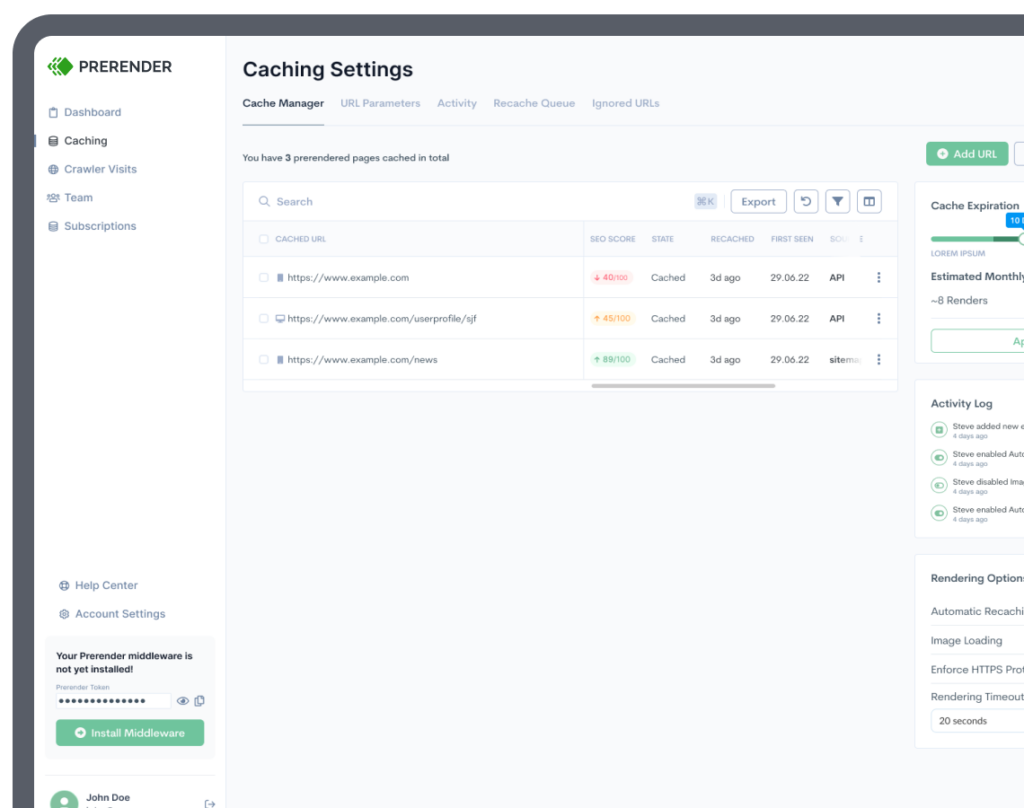The ecommerce industry is at a high-octane stage where only the best platforms get the most customers. Over the years, industry leaders like Amazon have shaped the average consumer’s expectations, and now every consumer expects fast load times, rich features, and highly personalized recommendations from ecommerce sites.
Due to the intense competition demand for quality in the ecommerce scene, the ability to deliver a captivating and seamless user experience (UX) is no longer a luxury for ecommerce businesses – it’s a necessity. For companies that use an all-in-one content management solution, delivering on these fronts requires rearchitecting their web technology stacks.
Many ecommerce platforms are now turning to a decoupled or headless architecture, using a headless CMS. Combined with a blazing-fast JavaScript framework like React, this modern web development approach brings significant advantages in terms of performance, scalability, and developer productivity.
In this article, we’ll look at what a headless CMS is, how it combines with React, and the benefits of combining these two technologies, especially in terms of performance. At the end of this article, you’ll understand how leveraging React alongside a headless CMS can empower ecommerce businesses to unlock a new level of performance, customization, and ultimately, customer satisfaction.
Without further Ado, let’s dive right into the benefit of using a headless CRM with React for ecommerce.
What is a Headless CMS?
As we’ve mentioned adopting a headless content management system brings significant advantages to ecommerce sites. But what exactly is a headless CMS?
Think of a headless CMS as a well-organized library. It holds all your books (content) in a clear and accessible manner. However, the library doesn’t provide tables and chairs (presentation layer) to read the books. You, as the developer or website owner, are free to choose the furniture (front-end framework like React) that best suits your reading experience (user interface)
Simply put, a headless CMS is a type of CMS that doesn’t come with a built-in front-end or presentation layer. It’s a backend-only content management system that does not include any front-end rendering capabilities or templating logic and functions solely as a content repository.
This means you can’t directly design or edit the visual appearance of your website within the CMS itself. Instead, a headless CMS focuses on storing, organizing, and managing your content. It then makes this content accessible through APIs (Application Programming Interfaces). These APIs act as bridges, allowing developers to fetch and display the content on any platform, using their preferred technology.
The “headless” name comes from these systems not having a default front end or “head” attached. They simply manage the content repository and infrastructure that feeds data to other presentation layers.
Combining Headless CMS and ReactJs
Now that we know what a headless CMS is, why do ecommerce platforms need a headless CMS?
Ecommerce businesses have complex needs when managing product cataloges, inventory, and order processing workflows. Most conventional CMS doesn’t have the flexibility to craft the hyper-responsive online shopping experiences that meet these needs, so ecommerce businesses have had to use headless CMS and a JavaScript framework to bridge the gap.
Many JavaScript frameworks work with a headless CMS, but combining headless CMS and ReactJs provides the perfect ecommerce stack. Here’s why:
- Enhanced Flexibility and Customization: ReactJS combined with headless CMS allows you to craft unique and tailored UIs that resonate with your brand and target audience, breaking free from the limitations of pre-defined templates often found in traditional CMS platforms.
- Omnichannel Experience: Since the content is decoupled from the presentation layer, it can be easily delivered to various platforms beyond the website, including mobile apps, smart TVs, or even voice assistants. This fosters a consistent and seamless experience for customers, regardless of their device or point of interaction.
- Component-Based Architecture and Virtual DOM: React’s component-based architecture allows developers to break down the UI into reusable and independent components. This modular approach fosters efficient development, easier maintenance, and a more structured and organized codebase. React’s virtual DOM also helps optimize rendering and update processes, leading to faster page load times and a smoother user experience. This is crucial for ecommerce websites, where every millisecond of loading time can impact conversion rates.
- Scalability and Flexibility: As your ecommerce business grows, so will your content and functionality needs. React’s modular components and the headless CMS’s flexible architecture enable easy scaling to accommodate increased traffic and data demands. You can independently scale the headless CMS and React application, ensuring seamless and efficient operation even under high load.
How React and Headless CMS Boosts Ecommerce Site Performance
While other frameworks may work with headless CMS, the unique aspects of React, from its component-based nature to its omnichannel experience and thriving developer ecosystem make it a strong contender for building high-performing and scalable ecommerce websites. However, where React for ecommerce truly shines is how it boosts website site speed and performance.
Traditionally, content management systems have offered an all-in-one web solution – from backend databases to frontend templates controlling a site’s actual pages. This monolithic architecture seems convenient initially but has downsides as complexity and traffic increase.
Stuffing business logic, storage systems, an entire JavaScript framework, and content rendering into a single platform cripples site speed and performance at scale. Over time, bloat accumulates across too many bundled components tangled tightly together. Most established CMS platforms struggle with the weight of decades-old technical debt, resulting in sluggish page loads that frustrate visitors
React is perfect for ecommerce because it solves this problem thanks to its blazing render speeds achieved through the use of a virtual DOM. Rather than directly manipulating the DOM like some alternatives, React conceptually stages changes first, which allows sites to batch updates efficiently. It then compares this “virtual” representation against the browser’s live DOM, calculating the minimal changes needed.
This diffing process means only essential DOM updates occur, rather than re-rendering entire pages needlessly as traffic grows. Combined with judiciously handling state changes, React provides e-commerce platforms with lightning-fast interfaces without frustrating lag – even on gigantic, data-heavy sites.
While React works this front-facing magic, the headless CMS content repository sustains uninterrupted ingestion and management behind the curtain. Content flows smoothly into storage and then gets served via APIs when requested, so the CMS stack hums steadily without concern over front-end computing constraints.
Together, the narrowly focused responsibilities of React for presentation and headless CMS for content delivery create an ecommerce architecture designed for high speed and performance. Visitors can browse and transact freely without triggering strained render cycles because components nimbly adjust to new data pulled from the CMS as users click and scroll.
Getting the Best out of React and Headless CMS
React and headless CMS is a match made in heaven, but only when properly implemented with js SEO best practices in mind. As a primarily client-side JavaScript framework, React apps can struggle to have their content crawled and indexed by search engines, and this can hamper discoverability and ultimately lead to low SERP rankings. Some ecommerce sites use server-side rendering(SSR) with React to combat this issue, but even that has its disadvantages.
To get the best javascript SEO performance out of a React and headless CMS application, you need to implement React prerendering or dynamic rendering with Prerender,
Prerender works by pre-building static HTML files of your ecommerce website pages and caching these files to display to crawlers, so rather than needing to render React on a server dynamically each time a bot accesses, Prerender generates a static site map ahead of time specifically for SEO.
This addresses common indexing struggles with client-side React routes that search engine crawlers can’t fully execute JavaScript to explore. Prerender follows all the React app links and data dependencies, takes page screenshots, and saves simple, crawlable HTML snapshots.
For ecommerce site owners, integrating Prerender takes no additional hosting resources or React server code. Yet, it improves indexing dramatically while solving most JavaScript-related problems your site can face.
So if you want to get the best out of React and a headless CMS and get your site crawled perfectly with minimal effort, you can get started with Prerender now and start enjoying all the benefits today.
Conclusion
The benefits of using a headless CMS with React for ecommerce are many. For ecommerce sites, the traffic volume necessitates breaking apart monolithic systems eventually. Combining the speed and flexibility of React with a headless CMS allows you to create scalable and flexible content that removes these scaling hurdles upfront. So rather than using a traditional CMS and face ripping it out and replacing it midway, using React plus headless CMS promises sustainable growth and performance from the get-go.
By combining React, headless CMS, and Prerender for an ecommerce platform, you’d be well-equipped to compete with the world’s best ecommerce platforms. The decoupled architecture means separating core competencies; React for UX, CMS for infrastructure, and Prerender for SEO.
Together these three modern technologies would empower online retailers to build incredibly fast, engaging ecommerce experiences that also tackle complex facets like order management and search optimization



